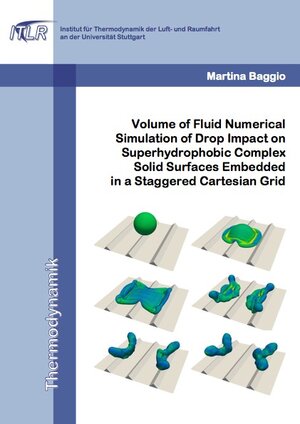
×
![Buchcover ISBN 9783843945776]()
Volume of Fluid Numerical Simulation of Drop Impact on Superhydrophobic Complex Solid Surfaces Embedded in a Staggered Cartesian Grid
von Martina BaggioSuperhydrophobic surfaces have a very low wettability. On them, falling droplets usually bounce off. There are many technical applications where this is relevant. One example is the impact of supercooled droplets in clouds on aeroplane wings. If the droplets stick, they freeze, and the growing ice sheet affects the aerodynamics of the airfoil. The impact dynamics of water droplets on flat superhydrophobic surfaces has been studied extensively. It was proven that, for a given droplet, the contact time on flat superhydrophobic surfaces could not be reduced under a certain threshold. Recent studies have shown that the contact time can be further minimized on surfaces with structures. In this work a numerical study of this phenomenon has been carried out using Free Surface 3D, a program for the direct numerical simulation of multi-phase flows developed at the Institute of Aerospace Thermodynamics at the University of Stuttgart. Free Surface 3D uses a rectilinear, Cartesian grid for space discretization, thus the embedding of complex, structured surfaces in this kind of grid was required. In this thesis, a cut-cell method was implemented. Thus, the control volumes that are crossed by the solid surface are cropped. This implementation is validated against different cases from literature for the impact of a single water drop on superhydrophobic surfaces of various shapes. The simulations agree very well with experimental data, not only because they can qualitatively represent the morphology of the impact for different values of the initial velocity, but also because the predictions for the contact time generally match those from the experiments. Furthermore, the information obtained from the numerical results not only corroborates some of the experimental findings, but also provides a deeper understanding of the physics of the interaction of a strongly deformed liquid mass with solid surfaces of various shapes.


